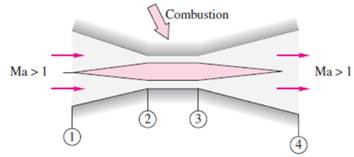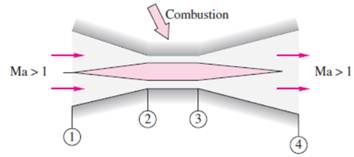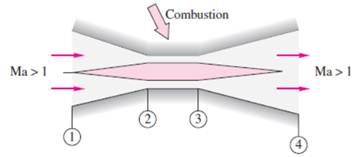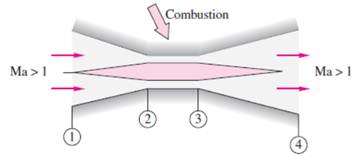
(a)
If the flow will still be supersonic in the throat.
Answer to Problem 9.51P
The Mach number at throat is equal to
The flow is supersonic.
Explanation of Solution
Given information:

Mach number at entrance is equal to,
The altitude is
Inlet area is
The minimum area is
Exit area is
For perfect gas, where
Area change is defined as,
Calculation:
Area change is defined as,
Therefore,
Therefore,
Throat area will be,
For section 2,
According to the table which represents the isentropic flow of a perfect gas,
Therefore by interpolation,
The flow is supersonic.
Conclusion:
The Mach number at throat is equal to
The flow is supersonic.
(b)
To find: the exit Mach number.
Answer to Problem 9.51P
Explanation of Solution
Given information:

Mach number at entrance is equal to,
The altitude is
Inlet area is
The minimum area is
Exit area is
For perfect gas, where
Area change is defined as,
Calculation:
Area change is defined as,
Therefore,
Throat area will be,
At exit,
According to the table which represents the isentropic flow of a perfect gas,
Therefore by interpolation,
Conclusion:
The Mach number at exit is equal to
(c)
To calculate:
The exit velocity.
Answer to Problem 9.51P
Explanation of Solution
Given information:

Mach number at entrance is equal to,
The altitude is
Inlet area is
The minimum area is
Exit area is
The temperature ratio is defined as,
Speed of sound is defined as,
Where,
The Mach number is defined as,
Where,
Calculation:
At altitude of
According to table A.6 which represents the properties of standard atmosphere,
Calculate the stagnation temperature,
Calculate the exit temperature,
Calculate the exit velocity,
Conclusion:
The exit velocity is equal to
(d)
To calculate:
The exit pressure.
Answer to Problem 9.51P
Explanation of Solution
Given information:

Mach number at entrance is equal to,
The altitude is
Inlet area is
The minimum area is
Exit area is
The pressure ratio is defined as,
Where,
Calculation:
At altitude of
According to table A.6 which represents the properties of standard atmosphere,
Calculate the stagnation pressure,
Calculate the exit pressure,
Conclusion:
The exit pressure is equal to
Want to see more full solutions like this?
Chapter 9 Solutions
FLUID MECHANICS-PHYSICAL ACCESS CODE
 Elements Of ElectromagneticsMechanical EngineeringISBN:9780190698614Author:Sadiku, Matthew N. O.Publisher:Oxford University Press
Elements Of ElectromagneticsMechanical EngineeringISBN:9780190698614Author:Sadiku, Matthew N. O.Publisher:Oxford University Press Mechanics of Materials (10th Edition)Mechanical EngineeringISBN:9780134319650Author:Russell C. HibbelerPublisher:PEARSON
Mechanics of Materials (10th Edition)Mechanical EngineeringISBN:9780134319650Author:Russell C. HibbelerPublisher:PEARSON Thermodynamics: An Engineering ApproachMechanical EngineeringISBN:9781259822674Author:Yunus A. Cengel Dr., Michael A. BolesPublisher:McGraw-Hill Education
Thermodynamics: An Engineering ApproachMechanical EngineeringISBN:9781259822674Author:Yunus A. Cengel Dr., Michael A. BolesPublisher:McGraw-Hill Education Control Systems EngineeringMechanical EngineeringISBN:9781118170519Author:Norman S. NisePublisher:WILEY
Control Systems EngineeringMechanical EngineeringISBN:9781118170519Author:Norman S. NisePublisher:WILEY Mechanics of Materials (MindTap Course List)Mechanical EngineeringISBN:9781337093347Author:Barry J. Goodno, James M. GerePublisher:Cengage Learning
Mechanics of Materials (MindTap Course List)Mechanical EngineeringISBN:9781337093347Author:Barry J. Goodno, James M. GerePublisher:Cengage Learning Engineering Mechanics: StaticsMechanical EngineeringISBN:9781118807330Author:James L. Meriam, L. G. Kraige, J. N. BoltonPublisher:WILEY
Engineering Mechanics: StaticsMechanical EngineeringISBN:9781118807330Author:James L. Meriam, L. G. Kraige, J. N. BoltonPublisher:WILEY





